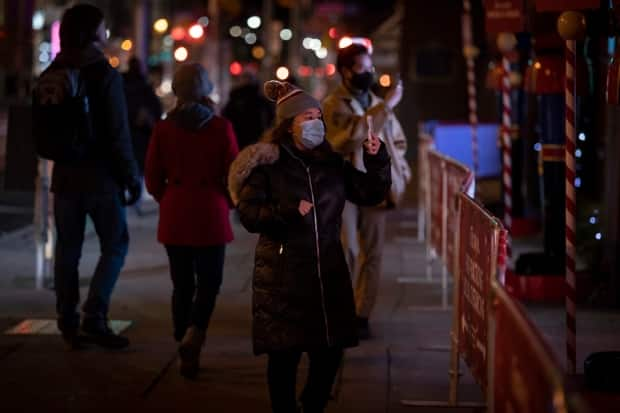Ontario's new COVID-19 modelling to show ICUs full by early February: sources
Ontario's latest COVID-19 modelling will project the province's intensive care units to be filled beyond capacity by early February and will also show how a new, more contagious variant of the coronavirus risks accelerating the spread of infections, sources tell CBC News.
Premier Doug Ford's cabinet is to meet Monday evening to decide on further pandemic restrictions, but a senior government official told reporters that the province's health advisers are not recommending a curfew.
"We worked all weekend, right until late hours last night," Ford said Monday as he arrived at his office in the provincial legislature. "We'll be going to cabinet with recommendations, and we'll make an announcement tomorrow."
Although the projections by Ontario's scientific advisers were presented to cabinet on Friday, the information is not slated to be made public until Tuesday.
Multiple sources who have seen the modelling tell CBC News it includes:
Forecasts putting the province on track to report a daily average of 6,000 new cases of COVID-19 before the end of January.
Survey data indicating that a large proportion of Ontarians are not following basic public health guidelines to slow the spread of COVID-19.
Mobility data showing a spike in movement by Ontarians in the days just before Christmas when the government imposed what it described as a provincewide lockdown, beginning Boxing Day.

"The modelling paints a very bleak picture both in terms of daily cases and the impact on hospitals," a senior government official told CBC News on Sunday.
"We are in a desperate situation, and when you see the modelling, you'll fall off your chair," Ford said Friday during a news conference filled with dire warnings of what Ontario faces from COVID-19.
"We are in a crisis, that's how I can describe it. It is scary. This is the most serious situation we've ever been in, ever, ever, since the beginning of this pandemic."
Modelling in line with that of government advisory group: sources
Despite Ford's statements, the new modelling does not show dramatically different trends from what Ontario's COVID-19 science table previously warned would happen with the pandemic in January, according to two sources who saw the material.
The government is also facing criticism for not acting more quickly in response to the trends.
"We're at a point where the numbers are rising so fast that every day of delay makes a difference," said Dr. Brooks Fallis, medical director of critical care for the William Osler Health System, which includes hospitals in Toronto and Brampton.
Ontario NDP Leader Andrea Horwath said in a statement Monday that Ford "keeps doing too little, too late."
"He's been stalling again for days," she said. "Delayed action against the surge in COVID-19 cases will cost lives."
Some public health experts have urged Ontario to impose a curfew to prevent people from gathering with others outside their own households, as well as measures to reduce the risks in workplaces that remain open.
"We don't have a lot of tools left in the tool box," the senior government official acknowledged.
Pace of growth accelerated
On Dec. 21, the Ford government announced what it described as a provincewide lockdown to take effect on Boxing Day. The measures included restricting most shops other than grocery stores and pharmacies to curbside pickup only, and limiting restaurants and bars to takeout and delivery.

The mobility data will raise questions about the government's decision not to impose tighter restrictions before Christmas, given how the growth in new cases began surging in late December.
In the two weeks leading up to Christmas, the province's average daily number of new cases grew at a pace of less than two per cent per day.
But over the past two weeks, the pace has accelerated much more rapidly, increasing by about 3.4 per cent per day.
If the growth in new cases continues at that rate, Ontario is on track to average more than 6,000 cases per day before the end of January. Ontario reported another 3,338 cases of COVID-19 Monday, as well as 29 more deaths of people with the illness, which pushed the province's total death toll to more than 5,000.
According to the province, the number of patients with COVID-19 in hospitals climbed to 1,563 on Monday, which is 80 more admissions than yesterday.

Modelling released in mid-December projected Ontario to have roughly 400 patients with COVID-19 in intensive care by this point in January if cases grew at a rate of three per cent daily. The ICUs hit that mark on Saturday, said a report from Critical Care Services Ontario, a provincial health agency.
According to sources who saw the new modelling, it projects nearly 800 coronavirus patients in ICU by early February if the daily growth in cases is at three per cent, and nearly 1,000 in intensive care if cases grow by five per cent daily.
Either scenario would pose a risk of Ontario's hospitals having more ICU patients than they can currently handle.
Rationing care could be on horizon
"This is truly a dire situation," infectious diseases specialist Dr. Isaac Bogoch of Toronto's Sinai Health and a member of Ontario's COVID-19 vaccine distribution task force, told CBC News Network on Monday.
"We are heading down a path where health-care teams will to have to make those very, very challenging choices of rationing care ... such as who is going to get the ventilator and who is not going to get the ventilator, who is going to live and who is not going to live."
Setting aside the effects of COVID-19, health officials say Ontario typically has a baseline of about 1,200 patients in intensive care at a time just because of everyday health emergencies, from heart attacks and strokes to car accidents or organ failure.
The province has the capacity for around 2,000 ICU patients in total, limited not just by the number of beds but also the availability of doctors, nurses and other health staff trained in intensive care.
Ford tweeted Sunday that Ontario's health-care system "is on the brink of being overwhelmed."
The information presented to cabinet about the potential effect of a coronavirus variant first reported in the U.K. is based on research by Queen's University mathematician Troy Day.
The new variant spreads more easily and faster than the original version of the virus, according to a report from researchers at Imperial College London released on Dec. 31, but it is not believed to be more deadly.
Day's research shows, based on evidence of how the virus is currently spreading in Britain, that Ontario could, by late February, see the overall number of new daily cases doubling in a stretch of just 10 to 15 days, twice as fast as the recent growth rate.
"That would be a really horrific situation," Day said in an interview with CBC News.
The survey data shows that a "concerning" proportion of people are not following public health guidelines in their personal behaviour, said the government official, adding that the data likely underestimates the actual level of non-compliance.
Documents summarizing the results, obtained by CBC News on Monday, show that 50 per cent of those surveyed in regions where the risk of COVID-19 is highest admitted to having had at least one visitor inside their home in the preceding four weeks.
CBC reported in October that the government planned to conduct such surveys of public health behaviours.

 Yahoo Sports
Yahoo Sports 